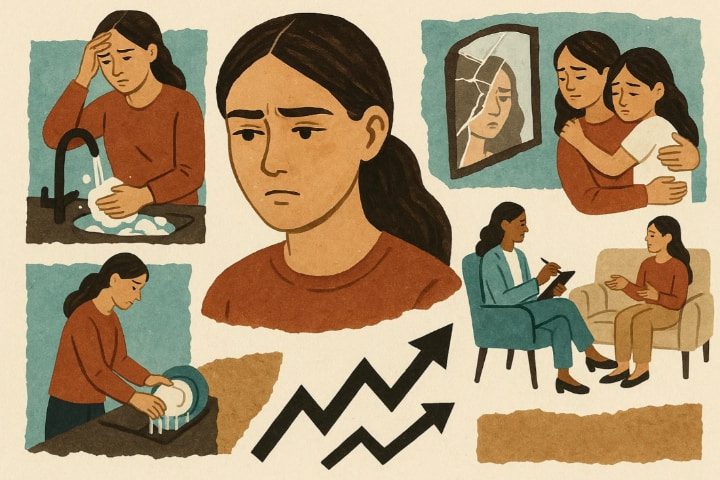The eldest daughter syndrome is a fact of life in most families all over the globe. It has a significant influence in the life of the oldest daughter. Like, her social life and family life usually burden her with expectations. So, it is essential that parents, caretakers and mental health professionals understand this syndrome. This syndrome has been discussed for decades and continues to maintain its relevance today. Luckily, families can easily provide more assistance to their eldest daughter by educating themselves on its causes, symptoms, and solutions.
What is eldest daughter syndrome?
The expectations tied to the oldest daughters and their general response to such expectations is known as elder daughter syndrome. It is a product of traditional, social and psychological factors. Like, the eldest daughter is said to be a second mother. So, in a way, she plays a parental role or a caregiver in most homes. Even if the parents have no intentions of putting such responsibilities on their daughter, this syndrome continues to present itself in many families.
An example is where an eldest daughter will take care of other siblings by helping them with homework, food or household chores. There are expectations that she can mediate family conflicts. This is an extra burden that can be started early in life, and increased as time passes. Most girls state that they feel that they have to be strong and dependable even at times when they feel strained.
These experiences pave the way towards what is often referred to as the plight of the eldest daughter. The feeling of duty influences behavior, priorities and self-image.
Common characteristics and symptoms of eldest daughter syndrome
There are many characteristics that you’ll find common in the eldest daughters of families across the globe. Even if there are regional, religious, and cultural differences, the following symptoms of the eldest daughter syndrome will remain consistent.



- Great sense of responsibility, even to the emotions and wellbeing of other people.
- Perfectionist conditions, unrealistic self and financial goals.
- The inability to request assistance, a sense of being self-sufficient is a requirement.
- Indulging in people pleasing behavior, which is from the fear of disappointing family or authority figures.
- Poor personal boundaries (frequently at the expense of siblings).
- Fear and worry regarding not meeting the family expectations.
- Regular confrontation of brothers and sisters.
- Desire to achieve in both academic and work life due to the need to demonstrate value.
- Stressful situations that result in obvious physical symptoms such as headaches or tiredness.
- Difficulty giving out tasks or duties.
- Maturity of emotions, covering personal weaknesses.
- Phobia to fail.
- Compulsiveness to make apologies on behalf of others.
- Silencing of the emotions to preserve the harmony of the family.
- Time deprivation: no time to leisure, hobby and self-care.
- Self-blame, criticism of self-failures
- Giving excessive attention to the results and less to the action.
- In ability to communicate negative feelings like anger or sadness.
- Unrealistic hope in the successes and failures of the siblings.
- Separation or solitude because of sharing no burdens.
These features are manifested in families. Studies indicate that there is a trend of self-sacrifice. Most of the eldest daughters also mention having to bury their own dreams in order to be in harmony with their family. Achievement at school can be accompanied by stress or anxiety. Moreover, Boundaries are not clearly defined thus making relationships difficult.
Symptoms may evolve with age. Eldest daughters are perfectionist and helpful as children. When they become teenagers, they experience more anxiety, problems with peer relationships, and diseases associated with stress. Similarly, when they become adults, it does not stop the tradition, as they tend to have a desire to fix things.
Use parental controls to know and help your teens more effective.
Understand the causes behind eldest daughter syndrome
Eldest daughter syndrome is deeply rooted. The environmental factors play a central role. The eldest child, mostly the eldest daughter, is perceived as a helper or co-parent in most cultures. Parental workload, single-parent homes, or big families enhance this expectation.
We can also learn by psychological theories. According to birth order theory, firstborn children become leaders but they also carry great expectations (Alfred Adler introduced the theory). The theory of social learning assumes that children learn by observing the behaviors of parents and leaving the responsibility to the eldest daughter. The family systems theory pinpoints the change of role that takes place when parents rely on the oldest child to support them.
Societal pressures also impose the pattern. Old-fashioned gender roles and cultural demands tend to force eldest daughters into early adulthood roles. This is the centre of what is today termed as the oldest child syndrome in girls.
Impact of the eldest daughter syndrome for teens & family
The eldest daughter syndrome can deeply shape both family dynamics and a teenager’s emotional growth. During adolescence, the pressure to meet family expectations often turns into stress, anxiety, or perfectionism. This is especially true at school or home. Many eldest daughters learn to hide their struggles to keep up their “responsible” image. Meanwhile, younger siblings may either rely on her for guidance or resent her authority.
This imbalance can strain family relationships. With little time left for personal interests or friendships, the eldest daughter may begin to feel isolated, which only adds more tension to the home environment when her distress surfaces. Let’s expand on how kids with eldest daughter syndrome affect families.
How kids with eldest daughter syndrome affect family?
The eldest daughter experiences role strain. She can sacrifice her needs in favor of the needs of siblings, neglecting to play and relax. Research indicates that the older children and particularly girls can get more stress and psychological exhaustion than their siblings.
When the oldest sibling decides to become an authority figure sibling relationships may suffer. There can be resentment, rivalry or emotional distance. Sahira Gonzalez’s 2025 thesis, “The Effects of Being the Oldest Daughter and a Caretaker,” from California State University, San Bernardino, examines how eldest daughters frequently assume caretaking and parental roles within families. This added responsibility often leads to emotional strain, burnout, and blurred identity boundaries, impacting mental health and family relationships. The study emphasizes the gendered expectations driving these pressures.
Individual needs are usually put in the background. Elders might deny themselves leisure, excursions or personal care. So, the stress to act as a role model takes its toll.
How eldest daughter syndrome affects adulthood?
The effects of the syndrome may persist long into adulthood. A lot of the first daughters end up becoming academic and career high achievers. This is as a result of high work ethics and perfectionism. They can be very successful in a challenging career but they might be at fault with work-life balance.
Eldest daughters of the family may become caregivers in relationships or have problems with boundaries. Self-esteem can also be contingent on the needs of other people. The risk is chronic stress, anxiety or burnout. There are also those women who fight imposter syndrome or conscience in the name of seeking personal happiness.
Without support, mental health may decrease. Therapy or self-awareness must break unhealthy cycles.
Positive sides of eldest daughter syndrome
Along with the negative impacts of elder daughter syndrome, there are strengths associated with it. A good number of eldest daughters are strong and self-reliant. They gain good leadership and organizational skills. Their empathetic and problem-solving skills are very welcome at the workplace and in relationships.
Such women are usually good friends and associates. Their wisdom and experience can also motivate brothers and sisters and friends. Managing responsibility prepares them to face future challenges.
The most positive trait here is resilience. Moreover, stress management adds to their flexibility, self-confidence, and ingenuity.
Tips for parents: navigate eldest daughter syndrome
Parents play a crucial role in supporting their eldest daughters and shaping the sharing of family responsibilities. Open communication and awareness of family dynamics are essential in easing the pressure that often falls on the oldest child. The first and most important step is acknowledging the unique emotional and practical burdens the eldest daughter may carry. Parents should intentionally create balance by dividing tasks more equally among all children and ensuring that the eldest is not automatically expected to lead or care for others.
This approach helps her enjoy her own childhood, form a healthy sense of identity, and build confidence independently. Let’s cover further on how parents can help kids affected by EDS.
How can parents prevent kids from eldest daughter syndrome?
- Equally share work between siblings.
- Do not automatically call the oldest the helper.
- Praise effort, not perfection.
- Establish achievable expectations with all the children.
- Create an open communication of feelings and stress.
- Demonstrate ideal healthy parent-sibling boundaries.
- Spend time with each child separately and equally.
- Learn problem-solving skills, conflict resolution skills.
- Watch out on stress or overwhelming situations, specifically for the eldest daughter.



We can also rely on tech to be more in-touch with our family’s mental health. Parental control tools like FlashGet Kids can be a lifesaver when you don’t have enough time to keep track of your child’s digital activities. Its features like keyword detection can help you catch early signs of depression, self-esteem issues, and stress. Moreover, it also enables parents with features like screen mirroring and notification tracking.
How to help eldest daughters heal from this syndrome?
- Encourage sharing by accepting emotions.
- Give the eldest a chance to have leisure and interpersonal interaction.
- Families should consider professional counseling when needed.
- Develop a family tradition of collective responsibility.
- Promote self-care practices and activities.
- Encourage the oldest that it is good to ask for help.
- Encourage peer relations and friendship.
- Encourage her to set personal goals that are not tied to family obligations.
- Recognize advancement and development with time.
Bottom line
The problem of elder daughter syndrome affects a good number of families, and in some cases, it is pretty severe. By comprehending the phenomenon, parents are able to react intelligently. Early intervention and identification avoids the eventual destruction of self-esteem and relationships. Similarly, consciousness enables the families to develop the strengths of all children. By prioritizing balance, empathy, and communication, families can achieve healthier, happier dynamics.
FAQs
Recommended books include Eldest Daughters: Stories of Responsibility and Resilience and The Eldest Daughter Effect.
Studies in developmental and family psychology link it to birth order, role theory, and family dynamics.
Eldest daughters tend to exhibit caring, leadership, and responsibility behaviors which are found in psychology.

